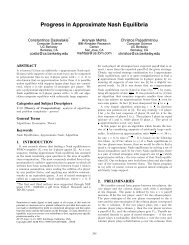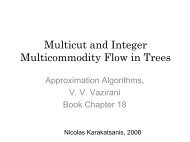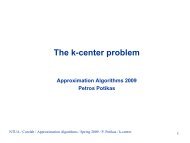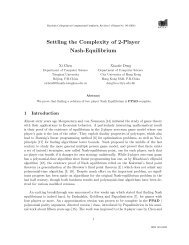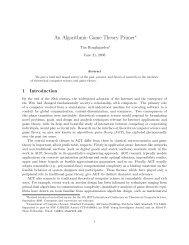Sponsored Search Auctions
Sponsored Search Auctions
Sponsored Search Auctions
- No tags were found...
Create successful ePaper yourself
Turn your PDF publications into a flip-book with our unique Google optimized e-Paper software.
<strong>Sponsored</strong> <strong>Search</strong> <strong>Auctions</strong>του Κυριάκου Σέργη
Introduction Web search engines like Google andYahoo! monetize their service byauctioning off advertising spacenext to their standard algorithmicsearch results.
Introduction For example, Apple or Best Buy maybid to appear among theadvertisements – usually locatedabove or to the right of thealgorithmic results
Introduction These sponsored results are displayedin a format similar to algorithmicresults: as a list of items each containing title, text description hyperlink to the advertiser’s Web page.
Introduction We call each position in the list aslot.
Introduction More than 50% of Web users visit asearch engine every day Americans conduct roughly 6 billion Websearches per month Over 13% of traffic to commercial sites isgenerated by search engines Over 40% of product searches on theWeb are initiated via search engines.
Introduction Today, Internet giants Google and Yahoo!boast a combined market capitalizationof over $150 billion, largely on thestrength of sponsored search. Roughly 85% of Google’s $4.1 billionand roughly 45% of Yahoo!’s $3.7 billionin 2005 revenue is likely attributable tosponsored search.
Introduction Advertisers specify: List of pairs of keywords Bids Total maximum daily or weekly budget. Every time a user searches for akeyword, an auction takes placeamong the set of interestedadvertisers who have not exhaustedtheir budgets.
Existing Models Static Vickrey Clarke Grooves Mechanism(VCG) Generalized First Price (GFP) Generalized Second Price (GSP) Dynamic On-line Allocation Problem
Static n bidders/advertisers k slots (k is fixed apriori – k
Static Αssumptions Bidders prefer a higher slot to a lower slotα ≥ α for i=1,2,..., k − 1ij i+1, jv iis independent of the slot position (static)CTR for a slot does not depend on the identity ofother bidders.CTRs are assumed to be common knowledge(static nature) not the reality - CTRs can fluctuate dramaticallyover small periods)
Static Revenue Maximization Allocative Efficiency
Revenue Maximization Result of Myerson The generalized Vickrey auction is appliednot to the actual values v j but to thecorresponding virtual values Generalized Vickrey auction with reserveprices
Revenue Maximization Maximization bidder payments:m a xn∑j=1pj
Revenue Maximization Surplus Allocation:maxn∑j=1n∑max x (b) ϕ (v )j=1x (b)v Virtual Surplus Allocation:jjj j jxj(b)1−F (v )ϕj(v j) = vj−f (v ) where: j jdF(z)j= Pr ⎡⎣vj ≤ z ⎤⎦ , fj(z) = F(z)jdzjjv j: expected CTR ofbidder j whobids b: drawn ind/ntlyfrom continuousprob.distribution
Revenue Maximization Expected Profit of a Truthful Mechanism M,isequal to the Expected Virtual Surplus:Et(M (t)) E ⎡⎤=t ⎢∑ϕj(v j)x j(t)⎥⎣ j⎦Proof:hE (p (b)) = p (b)f(b)db = ... = E ⎡ ⎣ ϕ (b)x (b) ⎤ ⎦∫b j j j jb=0Mechanism Truthful in Expectation:x (b)j Monotone non-decreasingbp (b ) = b x (b ) − ∫ x (z )dzj j j j0
Revenue Maximization Thus, Virtual surplus is truthfulif and only ifϕj(v )jis monotone non-decreasing invj Myerson Mechanism: Given bids b and F (here Bayesian – Nashdistribution), compute ‘virtual bids’: b ′ = ϕ (b ) Run VCG on b’ to get x’ and p’1 Output x=x’ and p with p = ϕ − (p ′)i i ii i i
Revenue Maximization F is the Bayesian – Nash distributionof of the generalized Vickrey(second price) auction (second price)with reserve prices Proof similar with the Vickrey (secondprice) auction (second price) withreserve price for 1 item
Revenue Maximization Revenue without reserve price:R01=3 Revenue with reserve price r:1 5r = , R1 =2 2 12
Revenue Maximization Revenue without reserve price: Given V A, B’s valuation is likely to lieanywhere between 0 and V A On average V B= V A/2 On average, V Bhalfway between 0 andV A On average, V Ahalfway between V Band1
Revenue Maximization Revenue without reserve price: E[V B] = 1/3 and E[V A] = 2/3 E[V B] = E[V A]/2 = 1/3
Revenue Maximization Revenue with reserve price r: It may be the case that a bidder haspositive valuation but negative virtualvaluation. Thus, for allocating a single item, theoptimal mechanism finds the bidder withthe largest nonnegative virtual valuationif there is one, and allocates to thatbidder
Revenue Maximization Revenue with reserve price r: bidder 1 (same for bidder 2) wins precisely when:ϕ (b ) ≥ max ϕ (b ),0 ⇒Since{ }1 1 2 2p = inf b : ϕ (b) ≥ ϕ (b ) ∧ ϕ (b) ≥ 0{ }1 1 2 2 1ϕ1= ϕ2= ϕ{ −}1 −1p1 = min b1, ϕ (0) = ϕ (0)ForF(z) = z , f (z) = 1 ⇒ ϕ (z) = 2z −1 ⇒ φ (0)= 2-1 1
Revenue Maximization Revenue with reserve price r: For r=1/2: Pr[both below 1/2]=1/2*1/2=1/4 Pr[both above 1/2]=1/2*1/2=1/4 Pr[one above 1/2]=1/2 Est. payoff both below = 0 Est. payoff both above = 4/6 Est. payoff one above = 1/21 1 4 1 1 5R1= ⋅ 0 + ⋅ + ⋅ =2 4 4 6 2 2 12
Allocative Efficiency Letxij= 1if bidder j is assigned slot ixij= 0otherwise
VCG Solution of LP:maxkn∑ ∑i= 1 j=1n∑j=1ki=1ijijijαv xij j ijs.t. x ≤ 1 , ∀i=1,2,...,k∑x ≤ 1 , ∀j=1,2,...,nx ≥ 0 , ∀i=1,2,...,k , ∀j=1,2,...,n
VCG Dual:k∑min p + qnii= 1 j=1i j ij jij∑js.t. p + q ≥ α v , ∀i=1,2,...,k , ∀j=1,2,...,np , q ≥ 0 , ∀i=1,2,...,k , ∀j=1,2,...,np : expected payment bidderiq : expected profit bidderj
VCG Special Case: CTRs bidder independent:α = µij Simple algorithm Northwest Corner Rule: Assign bidder with highest value top slot,second highest value second slot e.t.ciAssortative assignment
VCG Cons requires solving a computational problemwhich needs to be done online for everysearch and is expensive Other mechanisms better revenues thanVCG
GFP Let b1,…,bn be the bids. The GFPmechanism is as follows: Sorts bidders according to the bidsb1,…,bn. Assigns slots according to the order(assign top slot to the highest bidder andso on). Charge bidder i according to his bid. Yahoo! used a GFP auction until 2004.
GSP Let w1,…,wn be the weights on bidderswhich are static and independent of thebids b1,…,bn. The GSP mechanism is asfollows:Sort bidders bys ≥ s ≥... ≥ s (assume )si i i1 2 nAllocate slots to bidders 1 ,…,k in that order(i.e., bidder i gets the ith slot if i ≤ k ).Charge i the mininum bid he needs to retain hissi + 1slot (i.e., p ).i=wi=w b
GSP Overture model: For every i, wi= 1(bidders ordered according to the bidsonly). Google model: Google assigns weightsbased on the CTR at the top slot wi≃ αi1.The assumption here is that α i1 is static (orslow changing) This ordering is also called ‘revenue order’since si= αi1bi is the expected revenue ifi is put in slot 1 and there is only one slot.
GFP not truthful Payoff in general:
GSP not truthful Payoff in general:
GSP not truthful Payoff in general:
GSP not truthful Payoff in general:
VCG PayoffPayoff in general:eachbidder j would be made to pay the sum of(c c )b− −for every I below him i 1 i i
GSP vs VCG <strong>Search</strong> engines revenues under GSPbetter than VCG:c p − c p = (c −c )b ≤ c b − c b = c p −cpVCGVCGi i i+ 1 i+ 1 i i+ 1 i+ 1 i i+ 1 i+ 1 i+ 2 i i i+ 1 i+1
Equilibrium PropertiesGFP: Bayes-Nash symmetric equilibrium argument identical to that of the sealed bid firstprice auction for a single good for symmetricbidders (same distributions) the revenueequivalence theorem implies that revenue from GFPis the same as any other auction that allocatesaccording to bid order. Revenue Equivalence Principle Under certainweak assumptions, for every two Bayesian–Nashimplementations of the same social choice function f, we have that if for some type t’ of player i, theexpected (over the types of the other players)payment of player i is the same in the twomechanisms, then it is the same for every value ofi’s type t.
Equilibrium Properties GSP: Today nothing is known about theBayesian equilibrium of the GSP auction Special Case: CTRs are separable:α = µ βij i jspecial case:α = µ Locally Envy-Free equilibriaiji
GSP Equilibrium Properties Retaliation:Suppose advertiser k bids bk ′ can retaliate...kassignedto position i, and advertiser k ′ bids b > b→assigned to position (i - 1).→If k raises his bid slightly, his own payoff does notchange, but the payoff of the player above himdecreasesk′k
GSP Equilibrium Properties Vector of bids changes all time What if the vector converges to a restpoint? An advertiser in position i should not wantto “exchange” positions with the advertiserin position (i-1) “locally envy-free” vectors
GSP Equilibrium Properties An equilibrium of the simultaneous-movegame (Γ) induced by GSP is locally envyfreeif a player cannot improve his payoff byexchanging bids with the player ranked oneposition above himµ v − p ≥ µ v − pi g(i) i i−1 g(i) i−1
GSP Equilibrium PropertiesLEMMA 1: The outcome of any locally envy-freeequilibrium of auction Γ is a stable assignment.Proof:no advertiser can profitably rematch with a positionassigned to an advertiser below him (equilibrium)µ v − p ≥ µ v − pi g(i) i i+ 1 g(i) i+1
GSP Equilibrium Properties Proof (cont):show that no advertiser can profitably rematchwith the position assigned to an advertiser morethan one spot above himlocally envyfree equilibrium: matching must beassortativeµ v − p ≥ µ v − pi g(i) i i+ 1 g(i) i+1µ v − p ≥ µ v − pi+ 1 g(i+ 1) i+ 1 i g(i+1) ithus :( µ − µ )v ≥ ( µ − µ )vi i+ 1 g(i) i i+ 1 g(i+1)
GSP Equilibrium Properties Proof (cont):Suppose m ≤ i:µ v − p ≥ µ v − pi g ( i ) i i −1 g (i ) i−1µ v − p ≥ µ v − p...i −1 g ( i −1) i −1 i − 2 g ( i −1) i − 2µ v − p ≥ µ v − pm + 1 g ( m + 1) m + 1 m g ( m + 1) mthus :µ v − p ≥ µ v − pi g ( i ) i m g ( i ) m
GSP Equilibrium PropertiesLEMMA 2: If the number of advertisers is greaterthan the number of available positions then anystable assignment is an outcome of a locally envyfreeequilibrium of auction ΓProof:stable assignment ⇒ assortative ⇒ advertisers arelabeled in decreasing order of their bids:v > v ⇔ j < kjkThus, advertiser i match with position i, payment i
GSP Equilibrium Properties Proof (cont): Let:b=v1 1andpi−1bi= for i>1µi−1
GSP Equilibrium Properties Proof (cont): Let:b>bi i+1otherwise :p p p p≤ ⇒ v − ≥ v − ⇒ µ v − p ≥ µ v − pµ µ µ µi−1 i i−1 ii i i−1 i i−1 i i ii−1 i i−1 iSo, deviating and moving to a different positionin this strategy profile is at most as profitable forany player as rematching with the correspondingposition in the assignment game Γ
GSP Equilibrium Properties Let assign:pi→pV C GiTHEOREM 1: Strategy profile B* is a locallyenvy-free equilibrium of game Γ. In thisequilibrium, each advertiser’s position andpayment are equal to those in the dominantstrategyequilibrium of the game induced byVCG. In any other locally envy-free equilibriumof game Γ, the total revenue of the seller is atleast as high as in B*.
GSP Equilibrium Properties Proof:Payments under strategy profile B* coincide withVCG ⇒ B* locally envy-free equilibrium(construction)This assignment is: Best stable assignment for all advertisers Worst stable assignment for auctioneers
GSP Equilibrium Properties In any stable assignment:p ≥ µ v = pVCGk k+1 k kotherwise advertiser k+1 would find it profitable to match withposition k. Next,p − p ≥ ( µ − µ )vk−1 k k−1 k kotherwise advertiser k would find it profitable to match withposition k-1p − p ≥ ( µ − µk)vkk−1 k k−1⇒p ≥ ( µ − µ )v + p = ( µ − µ )v + p ≥ pVCG VCGk−1 k−1 k k k k−1 k k k k−1
Dynamic Aspects Online Allocation Problem <strong>Auctions</strong> are repeated with greatfrequency Model them as repeated games ofincomplete information For simplicity we assume that each pagehas only one slot for advertisements. The objective is to maximize totalrevenue while respecting the budgetconstraint of the bidders
Online Allocation Problem n number of advertisers and m the number ofkeywords. advertiser j has a bid of bij for keyword i anda total budget of Bj. Bids are small compared to budgets Since search engine has an accurate estimateof r i, the number of people searching forkeyword i for all 1 ≤ i ≤ m, it is easy toapproximate the optimal allocation using asimple LP xij be the total number of queries on keywordi allocated to bidder j
Online Allocation Problem LP:
Online Allocation Problem Dual:
Online Allocation ProblemComplementary slackness:bij(1-βj)=α’=max bik(1-β k ) , 1≤k≤n<strong>Search</strong> engine allocates its correspondingadvertisement space to the bidder j with thehighest bij (1-β j )if we allocate keyword i to agent now we obtain animmediate ‘payoff’ of bij.However, this consumes bij of the budget ⇒opportunity cost of bijβj.Reasonable to assign keyword i to j providedbij(1-βj) > 0
Online Allocation Problem Greedy:among the bidders whose budgets are notexhausted, allocate the query to the one withthe highest bid competitive ratio—the ratio between onlinealgorithm’s performance and the optimaloffline algorithm's performance Competitive ratio of greedy algorithm is1/2
Online Allocation Problem Greedy procedure is not guaranteed to findthe optimum solution: 2 bidders each with a budget of $2. b11 = 2, b12 = 2 − ε, b21 = 2, b22 = εIf query 1 arrives before query 2, it will beassigned to bidder 1. bidder 1’s budget is exhausted. When query 2arrives, it is assigned to bidder 2. Objective Function value of 2 + ε.The optimal solution would assign query 2 tobidder 1 and query 1 to bidder 2, yielding anobjective function value of 4 - ε.
Online Allocation ProblemSimilar to Graph MatchingProblem:Consider the set G of girlsmatched in Mopt but not inMgreedyThen every boy B adjacentto girls in G is alreadymatched in Mgreedy:|B|≤|Mgreedy|There are at least |G| suchboys (|G| ≤|B|) otherwisethe optimal algorithm could,not have matched all the Ggirls. So:|G| ≤|Mgreedy| By definition of G also:|Mopt| ≤|Mgreedy| + |G| |Mgreedy|/|Mopt| ≥1/2
Online Allocation Problem Can we do better? BALANCE algorithm: For each query, pick the advertiser withthe largest unspent budget
Online Allocation Problem Two advertisers A and B A bids on query x, B bids on x and y Both have budgets of $4 Query stream: xxxxyyyy BALANCE choice: ABABBB__ Optimal: AAAABBBB Competitive ratio = ¾
Analyzing BALANCE
BALANCE: General Result In the general case, worstcompetitive ratio of BALANCE is 1–1/e = approx. 0.63 Let’s see the worst case that givesthis ratio
Worst Case for BALANCE N advertisers: A1, A2, … AN Each with budget B > N Queries: N·B queries appear in N rounds ofB queries each:Bidding:Round 1 queries: bidders A1, A2, …, ANRound 2 queries: bidders A2, A3, …, ANRound queries: bidders Ai, …, AN Optimum allocation: Allocate round iqueries to Ai
Worst Case for BALANCE
BALANCE Algorithm βj’s as a function of the bidders spentbudget βj’s as a function of the bidders spent budget fj: the fraction of the budget of bidder j ,which has been spent Algorithm: Every time a query i arrives,allocate its advertisement space to the bidderj , who maximizes bijφ(fj)
BALANCE Algorithm Let k be a sufficiently large number used fordiscretizing the budgets of the bidders. Advertiser is of type j if she has spent within (j−1/k , j/k ] fraction of budget so far. sj: Total budget of type j bidders. For i = 0, 1, . . . , k, define wi: Amount of moneyspent by all bidders from the interval ( i−1/k , i/k ]of their budgets Discrete version of function φ:
BALANCE Algorithm When k tends to infinity: Let OPT be the solution of the optimal offlinealgorithm
BALANCE Algorithm Lemma: At the end of the algorithm, thisinequality holds:
BALANCE Algorithm Lemma Proof: Consider time query q arrives. OPT allocates q to a bidder of current type t ,whose type at the end of the algorithm will be t′. bopt , balg: amount of money that OPT and theBALANCE get from bidders for q. Let i be the type of the bidder that the algorithmallocates the query
BALANCE AlgorithmTheorem: The competitive ratio of Algorithm 1 is 1 − 1/e.Proof: By definition: Thus: We conclude that: Note that as k goes to infinity the left-handside tends to (1 − 1/e )OPT. Right-handrevenue of the BALANCE
Bibliographic NotesG. Demange, D. Gale, and M. Sotomayor. Multi-itemauctions. J. Political Econ., 94(4):863–872,1986B. Edelman, M. Ostrovsky, and M. Schwarz. Internetadvertising and the Generalized Second Price auction:Selling billions of dollars worth of keywords. Amer. Econ.Review, In pressS. Lahaie. An analysis of alternative slot auction designs forsponsored search. In Proc. 7th Conf. On ElectronicCommerce, Ann Arbor, MI, 2006G. Aggarwal, A. Goel, and R. Motwani. Truthful auctions forpricing search keywords. In Proc. 7 th ACM Conf. onElectronic Commerce, Ann Arbor, MI, 2006A. Mehta, A. Saberi, U. Vazirani, and V. Vazirani. AdWordsand generalized on-line matching. In Proc. 46th AnnualSymp. on Fdns. of Comp. Sci., 2005Internet







